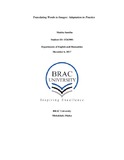| dc.contributor.advisor | Mahbub, Dr. Rifat | |
| dc.contributor.author | Samiha, Maisha | |
| dc.date.accessioned | 2018-03-07T04:19:27Z | |
| dc.date.available | 2018-03-07T04:19:27Z | |
| dc.date.copyright | 2017 | |
| dc.date.issued | 2017-12-06 | |
| dc.identifier.other | ID 15263001 | |
| dc.identifier.uri | http://hdl.handle.net/10361/9587 | |
| dc.description | This thesis is submitted in partial fulfillment of the requirements for the degree of Master of Arts in English, 2017. | en_US |
| dc.description | Cataloged from PDF version of thesis. | |
| dc.description | Includes bibliographical references (pages 78-79). | |
| dc.description.abstract | A film critic asked me recently if you should read the book first and then see the movie, or see
the movie and then read the book. I told him they don't have anything to do with each other.
There are all kinds of movies which I would go to see that I would never, ever read the book of.
Like the Jane Austen movies, or the E. M-Forster movies. There are so many books its way too
late for me to read. I'm not going to read Jane Austen now, but I enjoy the movies. I try to keep
up rather than go back" (qtd. in Strong ii).
This thesis stands between the theories of adaptation and my attempt at adapting multiple
texts of different genres into a photo story. I am going to focus on the journey of the adaptation
to understand the theories better and to understand the realistic concerns while adapting. In
addition, I will look at why it is difficult to film Literature - the text with the potential to be
adapted to a visual form often proves to be difficult. As primary materials, I have taken texts
such as – Book of Dhaka edited by Arunava Sinha and Pushpita Alam, Published in the streets of
Dhaka: Collected poems by Kaiser Haq, and a song “ei শহর আমার” by Shayan Chowdhury Arnob.
Through practical adaptation I will demonstrate the changes which occur in the transition
between media - between text and visuals. Movies have always been inspired by novels and there
is no doubt that today the opposite is trending too. They both have a narrative and the capability
of storytelling and hence mutually influence each other. In literature the reader imagines the
setting and the characters themselves, but cinema provides the audience the characters in flesh
and a defined space. This thesis is a unique experiment to comment on the practicality of
adaptations which we see in movies or discuss in our classrooms, often theoretically. | en_US |
| dc.description.statementofresponsibility | Maisha Samiha | |
| dc.format.extent | 79 pages | |
| dc.language.iso | en | en_US |
| dc.publisher | BRAC University | en_US |
| dc.rights | BRAC University thesis are protected by copyright. They may be viewed from this source for any purpose, but reproduction or distribution in any format is prohibited without written permission. | |
| dc.subject | Adaptation | en_US |
| dc.subject | Words | en_US |
| dc.subject | Images | en_US |
| dc.subject | Translating | en_US |
| dc.title | Translating words to images: adaptation in practice | en_US |
| dc.type | Thesis | en_US |
| dc.contributor.department | Department of English and Humanities, BRAC University | |
| dc.description.degree | M.A. in English | |

